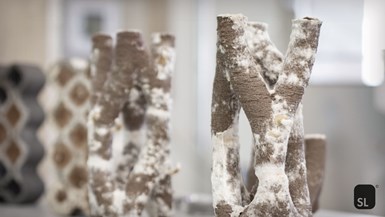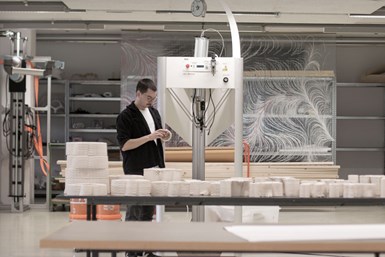Shape Lab Develops MyCera to Reinforce 3D Printed Clay Structures
Mycelium is an intelligently oriented fiber reinforcement that can increase the structural performance of 3D printed unfired clay elements and enable bio-welding of fired elements.
3D printing with mycelium-reinforced clay structures. Photo Credits: Shape Lab - Institute of Architecture and Media, Graz University of Technology
The Shape Lab research group — located at the Institute of Architecture and Media at Graz University of Technology — has developed a new material, MyCera, for 3D printing mycelium-reinforced structures. The material is composed of clay, wood sawdust and mycelium (vegetative part of fungi). The material is the result of research which focused on using mycelium as an intelligently oriented fiber reinforcement to increase the structural performance of 3D printed unfired clay structures and enable bio-welding of fired elements.
After initial testing, researchers say the proposed material composition could replace cement-based binders and offer a new approach to the sustainable fabrication of buildings in the near future.
The Shape Lab team used a Delta WASP 40100 Clay 3D printer to carry out their research and successfully print MyCera, taking advantage of the machine’s open system, scale and compatibility with paste-based material. Researchers say the overall research goal focused on finding a viable, long-term solution to the global problem of waste management and CO2 emissions, which also affects the building industry and construction waste management.
According to the researchers, mycelium has been proven to both increase the structural performance of clay 3D printed elements and act as a bio-binder between different pieces, creating a stable combined structure. MyCera showed notable structural properties when compared to the same material mixture without mycelium. It is assumed that the high increase in tensile strength is caused by the growth process that takes place after printing. This kind of intelligent fiber distribution could not have been achieved with a non-growing material.
The mycelium not only enhances the structural performance of 3D printed clay but also serves as a means to bio-weld various components together. Various structures were produced by assembling multiple elements together in a state where mycelium continues its growth. Mycelium fibers of the still-growing node elements formed connections through the expansion of the hyphal network and bio-welded adjacent elements together.
Although more tests need to be done to assert its durability, Shape Lab says that MyCera is a promising new composite material that could define a new approach to the sustainable fabrication of buildings in the near future. To verify the assumption of an advantageous structural effect of grown fiber connections, a comparison of mycelial fiber reinforcement and other fibers that are commonly used to increase tensile strength (such as basalt and glass fibers) is planned.
For more details on the research project, read the full WASP article. Watch process highlights in this video.
- Learn more about Wasp’s polymer and ceramic 3D printers for customized serial production. Italy-based Wasp offers 3D printing options for sustainable, customized serial production with polymers and ceramics.
- Read more about ceramics in this article on “10 Important Developments in Additive Manufacturing Seen at Formnext 2022.” And watch a short video from the trade show in which AM Editor-in-Chief Pete Zelinski shows a WASP 3D printing system for ceramics.
Related Content
Arburg Denmark Celebrates 25th Anniversary
The subsidiary has represented Arburg in Scandinavia since 1997.
Read MoreUSAF, GE Additive 3D Print Out-of-Production Metal Parts
The upcoming final phase of the Pacer Edge program is to establish the USAF’s own metal additive production infrastructure initially at Tinker Air Force Base in Oklahoma.
Read MoreConcept Sneaker Boasts One-Piece 3D Printed TPU Construction
The Reebok x Botter Concept Sneaker Engineered by HP premiered at Paris Fashion Week, hinting at manufacturing possibilities for the future of footwear.
Read More3 Points About 3D Printing Large Parts We Can Learn From the Lunar Habitat (Video)
Ingersoll Machine Tools describes the capabilities and promise of large-scale additive manufacturing as seen in the 3D printed sections of the Rosenberg Space Habitat.
Read MoreRead Next
At General Atomics, Do Unmanned Aerial Systems Reveal the Future of Aircraft Manufacturing?
The maker of the Predator and SkyGuardian remote aircraft can implement additive manufacturing more rapidly and widely than the makers of other types of planes. The role of 3D printing in current and future UAS components hints at how far AM can go to save cost and time in aircraft production and design.
Read MoreHybrid Additive Manufacturing Machine Tools Continue to Make Gains (Includes Video)
The hybrid machine tool is an idea that continues to advance. Two important developments of recent years expand the possibilities for this platform.
Read More3D Printing Brings Sustainability, Accessibility to Glass Manufacturing
Australian startup Maple Glass Printing has developed a process for extruding glass into artwork, lab implements and architectural elements. Along the way, the company has also found more efficient ways of recycling this material.
Read More














.png;maxWidth=300;quality=90)










